2013 NISSAN GT-R low oil pressure
[x] Cancel search: low oil pressurePage 8 of 346
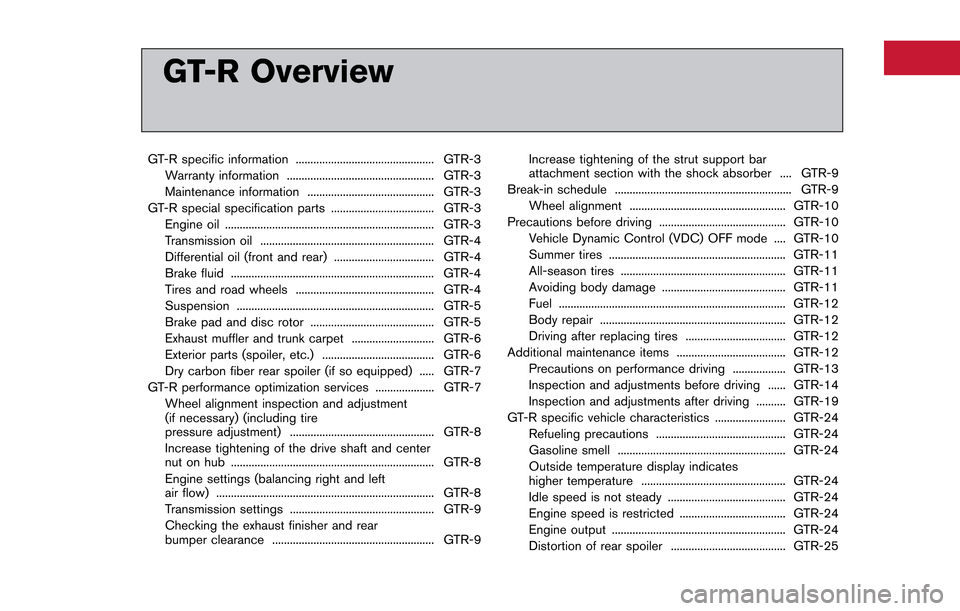
GT-R Overview
GT-R specific information ............................................... GTR-3Warranty information .................................................. GTR-3
Maintenance information ........................................... GTR-3
GT-R special specification parts ................................... GTR-3 Engine oil ....................................................................... GTR-3
Transmission oil ........................................................... GTR-4
Differential oil (front and rear) .................................. GTR-4
Brake fluid ..................................................................... GTR-4
Tires and road wheels ............................................... GTR-4
Suspension ................................................................... GTR-5
Brake pad and disc rotor .......................................... GTR-5
Exhaust muffler and trunk carpet ............................ GTR-6
Exterior parts (spoiler, etc.) ...................................... GTR-6
Dry carbon fiber rear spoiler (if so equipped) ..... GTR-7
GT-R performance optimization services .................... GTR-7 Wheel alignment inspection and adjustment
(if necessary) (including tire
pressure adjustment) ................................................. GTR-8
Increase tightening of the drive shaft and center
nut on hub ..................................................................... GTR-8
Engine settings (balancing right and left
air flow) ........................................................................\
.. GTR-8
Transmission settings ................................................. GTR-9
Checking the exhaust finisher and rear
bumper clearance ....................................................... GTR-9 Increase tightening of the strut support bar
attachment section with the shock absorber .... GTR-9
Break-in schedule ............................................................ GTR-9
Wheel alignment ..................................................... GTR-10
Precautions before driving ........................................... GTR-10 Vehicle Dynamic Control (VDC) OFF mode .... GTR-10
Summer tires ............................................................ GTR-11
All-season tires ........................................................ GTR-11
Avoiding body damage .......................................... GTR-11
Fuel ........................................................................\
..... GTR-12
Body repair ............................................................... GTR-12
Driving after replacing tires .................................. GTR-12
Additional maintenance items ..................................... GTR-12
Precautions on performance driving .................. GTR-13
Inspection and adjustments before driving ...... GTR-14
Inspection and adjustments after driving .......... GTR-19
GT-R specific vehicle characteristics ........................ GTR-24 Refueling precautions ............................................ GTR-24
Gasoline smell ......................................................... GTR-24
Outside temperature display indicates
higher temperature ................................................. GTR-24
Idle speed is not steady ........................................ GTR-24
Engine speed is restricted .................................... GTR-24
Engine output ........................................................... GTR-24
Distortion of rear spoiler ....................................... GTR-25
Page 14 of 346
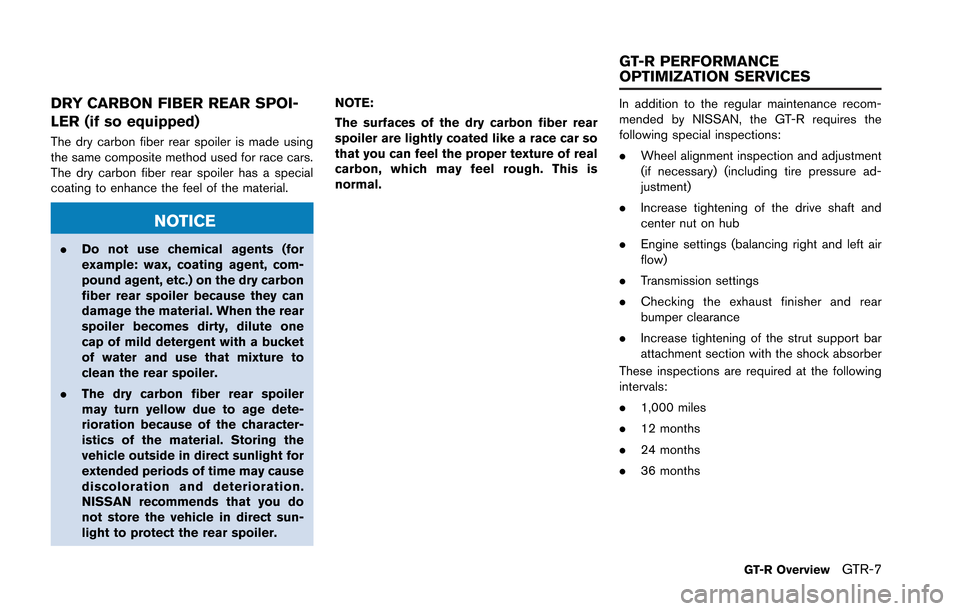
DRY CARBON FIBER REAR SPOI-
LER (if so equipped)
The dry carbon fiber rear spoiler is made using
the same composite method used for race cars.
The dry carbon fiber rear spoiler has a special
coating to enhance the feel of the material.
NOTICE
.Do not use chemical agents (for
example: wax, coating agent, com-
pound agent, etc.) on the dry carbon
fiber rear spoiler because they can
damage the material. When the rear
spoiler becomes dirty, dilute one
cap of mild detergent with a bucket
of water and use that mixture to
clean the rear spoiler.
. The dry carbon fiber rear spoiler
may turn yellow due to age dete-
rioration because of the character-
istics of the material. Storing the
vehicle outside in direct sunlight for
extended periods of time may cause
discoloration and deterioration.
NISSAN recommends that you do
not store the vehicle in direct sun-
light to protect the rear spoiler. NOTE:
The surfaces of the dry carbon fiber rear
spoiler are lightly coated like a race car so
that you can feel the proper texture of real
carbon, which may feel rough. This is
normal.
In addition to the regular maintenance recom-
mended by NISSAN, the GT-R requires the
following special inspections:
.
Wheel alignment inspection and adjustment
(if necessary) (including tire pressure ad-
justment)
. Increase tightening of the drive shaft and
center nut on hub
. Engine settings (balancing right and left air
flow)
. Transmission settings
. Checking the exhaust finisher and rear
bumper clearance
. Increase tightening of the strut support bar
attachment section with the shock absorber
These inspections are required at the following
intervals:
. 1,000 miles
. 12 months
. 24 months
. 36 months
GT-R OverviewGTR-7
GT-R PERFORMANCE
OPTIMIZATION SERVICES
Page 20 of 346

PRECAUTIONS ON PERFORMANCE
DRIVING
The information and specifications in this
section apply only when engaging in
performance driving.
Checking the temperature of the
coolant and oils on the multi func-
tion display
When the temperatures of the engine coolant
and oil, and the oil pressure exceed the normal
range, the color of the meter on the multi
function display changes to red to warn the
driver. When engaging in high performance
driving, switch the display to the function meter
to display the temperature of the engine coolant
and oil, and the oil pressure. When the color of
the meter display changes to red, perform cool
down driving. When the values of the tempera-
ture and pressure return to the normal range, the
color of the meter display will turn back to white.
Warning temperature:
.Engine coolant temperature is 2308 F
(1108C) or higher:
If the engine coolant temperature increases
above 2308F (1108C) , the color of the meter
display on the multi function display changes
to red to warn of a possible overheat condition and engine output is reduced.
. Engine oil temperature is 2758F (1358C) or
higher:
If the engine oil temperature is higher than
2758F (1358C), the meter display changes
to red, maximum engine speed is automati-
cally limited to 4,000 rpm, and the transmis-
sion automatically changes from the
&Mposition to the&Aposition.
. Transmission oil temperature is 2848 F
(1408C) or higher:
If the transmission oil temperature increases
to over 2848F (1408C) , the color of the
meter display changes to red. However, the
vehicle can continue to be driven until the
temperature reaches 2958F (1468C) . If the
oil temperature exceeds 2848 F (1408C)
while driving (the color of the meter dis-
played in red) , change both the transmission
oil and the differential oil after driving
because these fluids have deteriorated
because of the heat.
Cool down
The information and specifications in this
section apply only when engaging in
performance driving.
Cool down the vehicle to help extend the life of the vehicle if coolant temperatures are extremely
high. Drive the vehicle at 37 to 50 MPH (60 to
80 km/h), in 5th or 6th gear for 2 to 3 miles (3 to
5 km) and then stop the engine.
Refueling precautions
WARNING
Do not attempt to top off the fuel tank
after the fuel pump nozzle shuts off
automatically. Continued refueling may
cause fuel overflow, resulting in fuel
spray and possibly a fire. The fuel tank
is full at the first automatic shutoff.
To maximize vehicle performance, the fuel tank is
located as low as possible to lower the vehicle
center of gravity. The tank is also divided into
two parts. This fuel tank design causes higher
pressures inside the tank than other vehicles so
fuel spillage is possible by trying to top off the
fuel tank after automatic shutoff.
The fuel tank pressure is higher when the vehicle
is hot, especially if the tank is more than half full.
If the cap is opened when the vehicle is hot, it
may cause fuel spray and there may be a hissing
noise. Open the cap slowly, releasing the
pressure from the tank gradually. Also, if the
GT-R OverviewGTR-13
Page 22 of 346
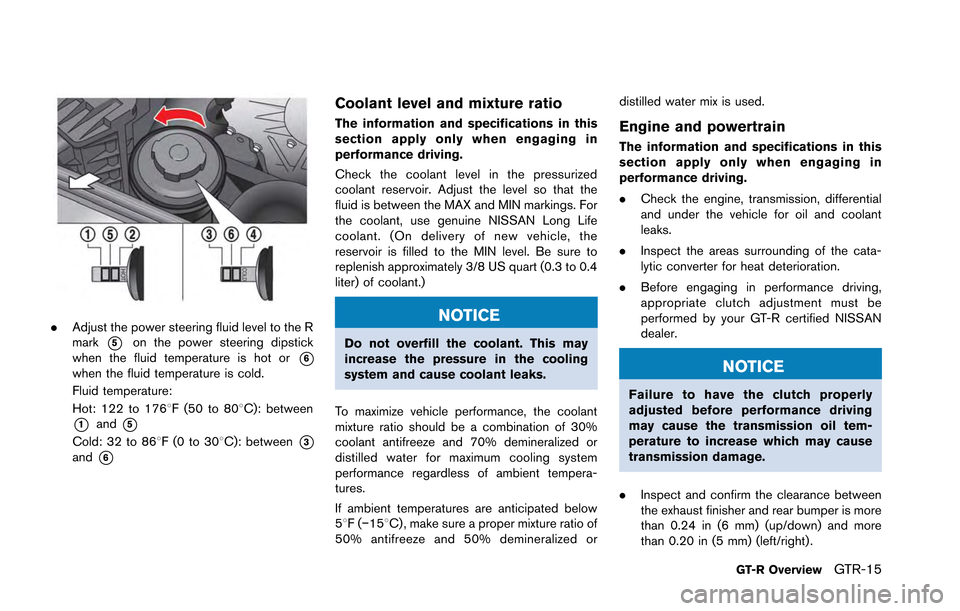
.Adjust the power steering fluid level to the R
mark
*5on the power steering dipstick
when the fluid temperature is hot or
*6when the fluid temperature is cold.
Fluid temperature:
Hot: 122 to 1768F (50 to 808C): between
*1and*5
Cold: 32 to 868F(0to30 8C): between*3and*6
Coolant level and mixture ratio
The information and specifications in this
section apply only when engaging in
performance driving.
Check the coolant level in the pressurized
coolant reservoir. Adjust the level so that the
fluid is between the MAX and MIN markings. For
the coolant, use genuine NISSAN Long Life
coolant. (On delivery of new vehicle, the
reservoir is filled to the MIN level. Be sure to
replenish approximately 3/8 US quart (0.3 to 0.4
liter) of coolant.)
NOTICE
Do not overfill the coolant. This may
increase the pressure in the cooling
system and cause coolant leaks.
To maximize vehicle performance, the coolant
mixture ratio should be a combination of 30%
coolant antifreeze and 70% demineralized or
distilled water for maximum cooling system
performance regardless of ambient tempera-
tures.
If ambient temperatures are anticipated below
58F( −158C) , make sure a proper mixture ratio of
50% antifreeze and 50% demineralized or distilled water mix is used.
Engine and powertrain
The information and specifications in this
section apply only when engaging in
performance driving.
.
Check the engine, transmission, differential
and under the vehicle for oil and coolant
leaks.
. Inspect the areas surrounding of the cata-
lytic converter for heat deterioration.
. Before engaging in performance driving,
appropriate clutch adjustment must be
performed by your GT-R certified NISSAN
dealer.
NOTICE
Failure to have the clutch properly
adjusted before performance driving
may cause the transmission oil tem-
perature to increase which may cause
transmission damage.
. Inspect and confirm the clearance between
the exhaust finisher and rear bumper is more
than 0.24 in (6 mm) (up/down) and more
than 0.20 in (5 mm) (left/right) .
GT-R OverviewGTR-15
Page 30 of 346

Suspension and wheel alignment
.Check the steering and suspension system
and other links for loose and/or damaged
parts.
. Measure and adjust the wheel alignment.
Contact a GT-R certified NISSAN dealer to
adjust the wheel alignment to the recom-
mended setting for normal driving.
Wheels and tires
.Check tire wear and cracking.
. Inspect the tire side wall for damage.
. Check the tire pressure and adjust the
pressure as necessary when the tires are
cold. (
“Wheels and tires” page GTR-
16) If you do not drive under the conditions
listed in this section, see (
“Wheels and
tires” page 8-31)
. Check that the wheel nuts are not stripped.
Check if there is no deformation on the
contact surface of the wheel nuts.
. Make sure the wheel nuts are tight.
(
“Wheels and tires” page 8-31)
. Make sure the drive shaft nuts are tight.
. Check wheel hub run out and that the wheel
rotates smoothly without any friction. Check
these with the tires removed whenever an inspection is performed with the vehicle
jacked up.
. Make sure the tire has not slipped on the
wheel causing the assembly to be out of
balance. The reference marks on the tire and
wheel should be aligned. If the reference
marks are not aligned, the tire has slipped on
the wheel. Have the wheels/tires reba-
lanced. Make sure the old reference marks
are erased and new reference marks are
applied to the wheel and tire. When instal-
ling new tires on the wheels, make sure new
reference marks are applied to the wheels
and tires. (
“Wheels and tires” page
GTR-16)
. Make sure that the TPMS sensor installation
nuts and the sensor valve are tight and there
is no nitrogen leak.
Brakes
.Check for the heat deterioration of the
brakes and parts around the brakes.
. Check the condition of the brake pads and
disc rotors and replace them as necessary.
Engine and powertrain
.Check the engine, transmission, differential
and under the vehicle for oil and coolant leaks.
. Inspect the area surrounding the catalytic
converter for heat deterioration.
. Inspect and confirm the clearance between
the exhaust finisher and rear bumper is more
than 0.24 in (6 mm) (up/down) and more
than 0.20 in (5 mm) (left/right) .
. The clutch clearance and shift fork position
may need to be adjusted.
. Inspect the dust boot of the drive shaft
universal joint for cracks or damage.
. Check that there is no abnormal noise,
vibrations or warning lights illuminated when
making tight turns at slow speed (for tight
corner braking phenomenon) .
GT-R OverviewGTR-23
Page 31 of 346
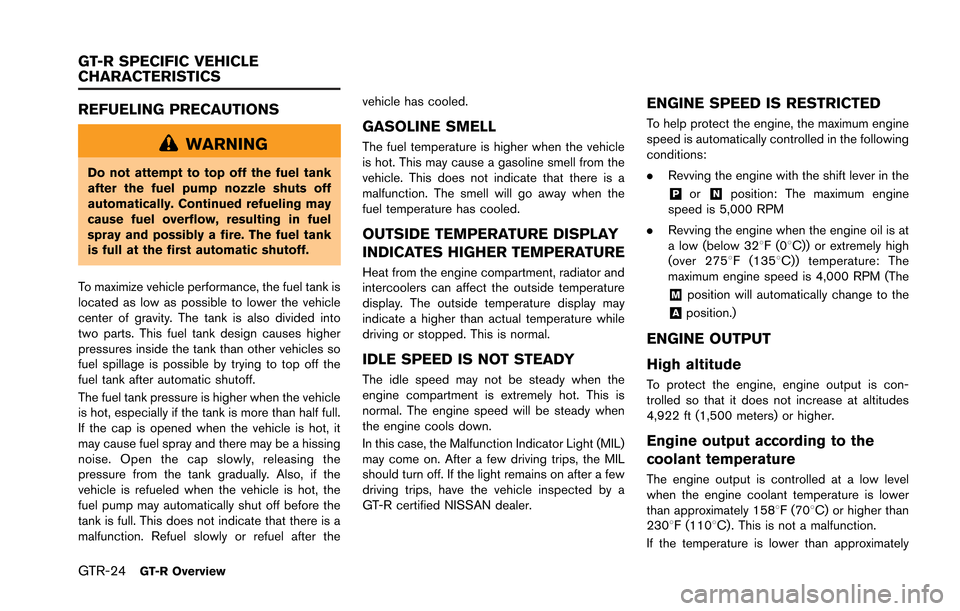
GTR-24GT-R Overview
REFUELING PRECAUTIONS
WARNING
Do not attempt to top off the fuel tank
after the fuel pump nozzle shuts off
automatically. Continued refueling may
cause fuel overflow, resulting in fuel
spray and possibly a fire. The fuel tank
is full at the first automatic shutoff.
To maximize vehicle performance, the fuel tank is
located as low as possible to lower the vehicle
center of gravity. The tank is also divided into
two parts. This fuel tank design causes higher
pressures inside the tank than other vehicles so
fuel spillage is possible by trying to top off the
fuel tank after automatic shutoff.
The fuel tank pressure is higher when the vehicle
is hot, especially if the tank is more than half full.
If the cap is opened when the vehicle is hot, it
may cause fuel spray and there may be a hissing
noise. Open the cap slowly, releasing the
pressure from the tank gradually. Also, if the
vehicle is refueled when the vehicle is hot, the
fuel pump may automatically shut off before the
tank is full. This does not indicate that there is a
malfunction. Refuel slowly or refuel after the vehicle has cooled.
GASOLINE SMELL
The fuel temperature is higher when the vehicle
is hot. This may cause a gasoline smell from the
vehicle. This does not indicate that there is a
malfunction. The smell will go away when the
fuel temperature has cooled.
OUTSIDE TEMPERATURE DISPLAY
INDICATES HIGHER TEMPERATURE
Heat from the engine compartment, radiator and
intercoolers can affect the outside temperature
display. The outside temperature display may
indicate a higher than actual temperature while
driving or stopped. This is normal.
IDLE SPEED IS NOT STEADY
The idle speed may not be steady when the
engine compartment is extremely hot. This is
normal. The engine speed will be steady when
the engine cools down.
In this case, the Malfunction Indicator Light (MIL)
may come on. After a few driving trips, the MIL
should turn off. If the light remains on after a few
driving trips, have the vehicle inspected by a
GT-R certified NISSAN dealer.
ENGINE SPEED IS RESTRICTED
To help protect the engine, the maximum engine
speed is automatically controlled in the following
conditions:
.
Revving the engine with the shift lever in the
&Por&Nposition: The maximum engine
speed is 5,000 RPM
. Revving the engine when the engine oil is at
a low (below 328F(0 8C)) or extremely high
(over 2758 F (1358C)) temperature: The
maximum engine speed is 4,000 RPM (The
&Mposition will automatically change to the
&Aposition.)
ENGINE OUTPUT
High altitude
To protect the engine, engine output is con-
trolled so that it does not increase at altitudes
4,922 ft (1,500 meters) or higher.
Engine output according to the
coolant temperature
The engine output is controlled at a low level
when the engine coolant temperature is lower
than approximately 1588F (708C) or higher than
2308F (1108C). This is not a malfunction.
If the temperature is lower than approximately
GT-R SPECIFIC VEHICLE
CHARACTERISTICS
Page 36 of 346
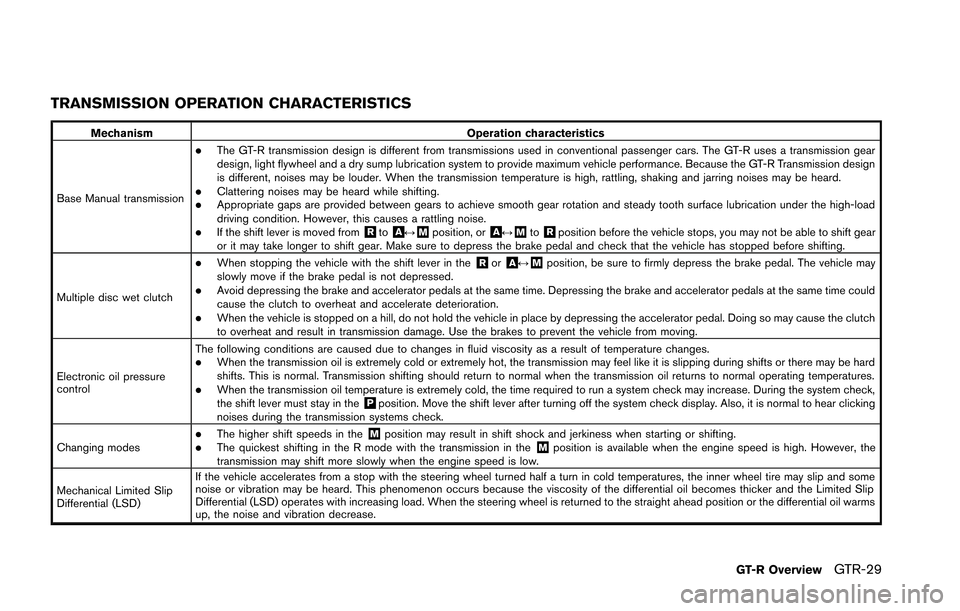
TRANSMISSION OPERATION CHARACTERISTICS
MechanismOperation characteristics
Base Manual transmission
.The GT-R transmission design is different from transmissions used in conventional passenger cars. The GT-R uses a transmission gear
design, light flywheel and a dry sump lubrication system to provide maximum vehicle performance. Because the GT-R Transmission design
is different, noises may be louder. When the transmission temperature is high, rattling, shaking and jarring noises may be heard.
.Clattering noises may be heard while shifting..Appropriate gaps are provided between gears to achieve smooth gear rotation and steady tooth surface lubrication under the high-load
driving condition. However, this causes a rattling noise.
.If the shift lever is moved from&Rto&A↔&Mposition, or&A↔&Mto&Rposition before the vehicle stops, you may not be able to shift gear
or it may take longer to shift gear. Make sure to depress the brake pedal and check that the vehicle has stopped before shifting.
Multiple disc wet clutch
.When stopping the vehicle with the shift lever in the&Ror&A↔&Mposition, be sure to firmly depress the brake pedal. The vehicle may
slowly move if the brake pedal is not depressed.
.Avoid depressing the brake and accelerator pedals at the same time. Depressing the brake and accelerator pedals at the same time could
cause the clutch to overheat and accelerate deterioration.
.When the vehicle is stopped on a hill, do not hold the vehicle in place by depressing the accelerator pedal. Doing so may cause the clutch
to overheat and result in transmission damage. Use the brakes to prevent the vehicle from moving.
Electronic oil pressure
control The following conditions are caused due to changes in fluid viscosity as a result of temperature changes.
.When the transmission oil is extremely cold or extremely hot, the transmission may feel like it is slipping during shifts or there may be hard
shifts. This is normal. Transmission shifting should return to normal when the transmission oil returns to normal operating temperatures.
.When the transmission oil temperature is extremely cold, the time required to run a system check may increase. During the system check,
the shift lever must stay in the&Pposition. Move the shift lever after turning off the system check display. Also, it is normal to hear clicking
noises during the transmission systems check.
Changing modes
.The higher shift speeds in the&Mposition may result in shift shock and jerkiness when starting or shifting..The quickest shifting in the R mode with the transmission in the&Mposition is available when the engine speed is high. However, the
transmission may shift more slowly when the engine speed is low.
Mechanical Limited Slip
Differential (LSD) If the vehicle accelerates from a stop with the steering wheel turned half a turn in cold temperatures, the inner wheel tire may slip and some
noise or vibration may be heard. This phenomenon occurs because the viscosity of the differential oil becomes thicker and the Limited Slip
Differential (LSD) operates with increasing load. When the steering wheel is returned to the straight ahead position or the differential oil warms
up, the noise and vibration decrease.
GT-R OverviewGTR-29
Page 48 of 346
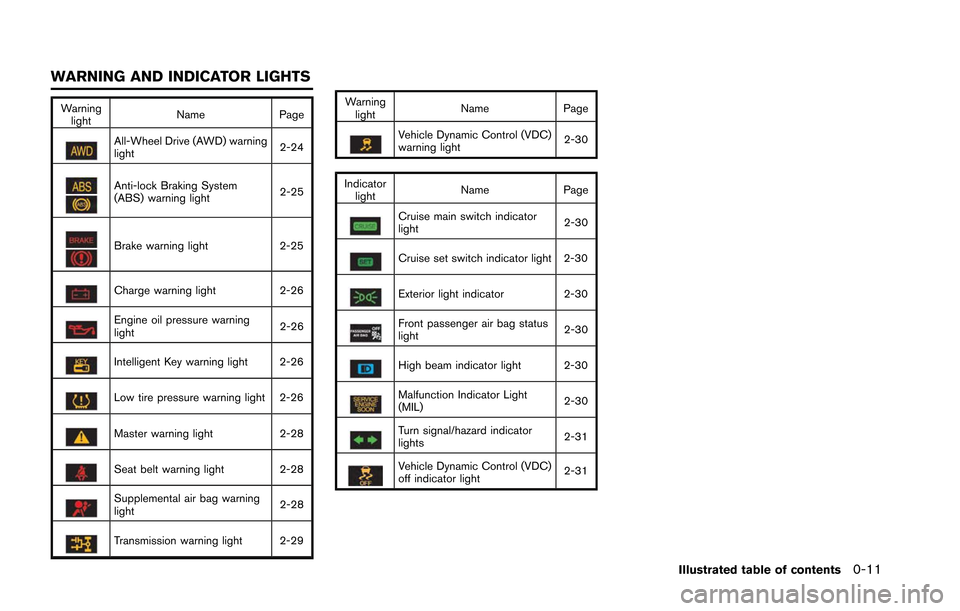
Warninglight Name
Page
All-Wheel Drive (AWD) warning
light 2-24
Anti-lock Braking System
(ABS) warning light2-25
Brake warning light
2-25
Charge warning light 2-26
Engine oil pressure warning
light 2-26
Intelligent Key warning light 2-26
Low tire pressure warning light 2-26
Master warning light
2-28
Seat belt warning light 2-28
Supplemental air bag warning
light 2-28
Transmission warning light 2-29 Warning
light Name
Page
Vehicle Dynamic Control (VDC)
warning light 2-30
Indicator light Name
Page
Cruise main switch indicator
light 2-30
Cruise set switch indicator light 2-30
Exterior light indicator
2-30
Front passenger air bag status
light 2-30
High beam indicator light 2-30
Malfunction Indicator Light
(MIL)2-30
Turn signal/hazard indicator
lights
2-31
Vehicle Dynamic Control (VDC)
off indicator light2-31
Illustrated table of contents0-11
WARNING AND INDICATOR LIGHTS